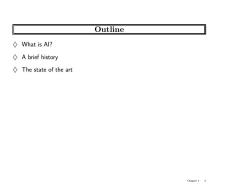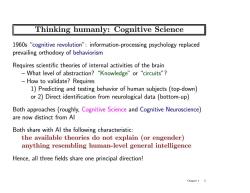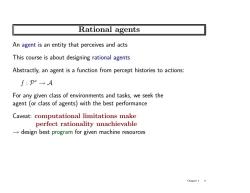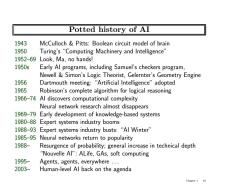《Artificial Intelligence:A Modern Approach》教学资源(讲义,英文版)chapter01

ARTIFICIAL INTELLIGENCE CHAPTER 1 Chapter 11
Artificial Intelligence Chapter 1 Chapter 1 1

Outline ◇What is Al? ◇A brief history ◇The state of the art Chapter 1 2
Outline ♦ What is AI? ♦ A brief history ♦ The state of the art Chapter 1 2

What is AI☒ Systems that think like humans Systems that think rationally Systems that act like humans Systems that act rationally Chapter 1 3
What is AI? Systems that think like humans Systems that think rationally Systems that act like humans Systems that act rationally Chapter 1 3

Acting humanly:The Turing test Turing(1950)"Computing machinery and intelligence": ◇“Can machines think?”→“Can machines behave intelligently?" Operational test for intelligent behavior:the Imitation Game HUMAN HUMAN INTERROGATOR AI SYSTEM Predicted that by 2000,a machine might have a 30%chance of fooling a lay person for 5 minutes Anticipated all major arguments against Al in following 50 years Suggested major components of Al:knowledge,reasoning,language understanding,learning Problem:Turing test is not reproducible,constructive,or amenable to mathematical analysis Chapter 1 4
Acting humanly: The Turing test Turing (1950) “Computing machinery and intelligence”: ♦ “Can machines think?” −→ “Can machines behave intelligently?” ♦ Operational test for intelligent behavior: the Imitation Game AI SYSTEM HUMAN ? HUMAN INTERROGATOR ♦ Predicted that by 2000, a machine might have a 30% chance of fooling a lay person for 5 minutes ♦ Anticipated all major arguments against AI in following 50 years ♦ Suggested major components of AI: knowledge, reasoning, language understanding, learning Problem: Turing test is not reproducible, constructive, or amenable to mathematical analysis Chapter 1 4

Thinking humanly:Cognitive Science 1960s "cognitive revolution":information-processing psychology replaced prevailing orthodoxy of behaviorism Requires scientific theories of internal activities of the brain -What level of abstraction?“Knowledge'”or“circuits"? How to validate?Requires 1)Predicting and testing behavior of human subjects(top-down) or 2)Direct identification from neurological data(bottom-up) Both approaches(roughly,Cognitive Science and Cognitive Neuroscience) are now distinct from Al Both share with Al the following characteristic: the available theories do not explain (or engender) anything resembling human-level general intelligence Hence,all three fields share one principal direction! Chapter 1 5
Thinking humanly: Cognitive Science 1960s “cognitive revolution”: information-processing psychology replaced prevailing orthodoxy of behaviorism Requires scientific theories of internal activities of the brain – What level of abstraction? “Knowledge” or “circuits”? – How to validate? Requires 1) Predicting and testing behavior of human subjects (top-down) or 2) Direct identification from neurological data (bottom-up) Both approaches (roughly, Cognitive Science and Cognitive Neuroscience) are now distinct from AI Both share with AI the following characteristic: the available theories do not explain (or engender) anything resembling human-level general intelligence Hence, all three fields share one principal direction! Chapter 1 5

Thinking rationally:Laws of Thought Normative (or prescriptive)rather than descriptive Aristotle:what are correct arguments/thought processes? Several Greek schools developed various forms of logic: notation and rules of derivation for thoughts; may or may not have proceeded to the idea of mechanization Direct line through mathematics and philosophy to modern Al Problems: 1)Not all intelligent behavior is mediated by logical deliberation 2)What is the purpose of thinking?What thoughts should I have out of all the thoughts (logical or otherwise)that I could have? Chapter 1 6
Thinking rationally: Laws of Thought Normative (or prescriptive) rather than descriptive Aristotle: what are correct arguments/thought processes? Several Greek schools developed various forms of logic: notation and rules of derivation for thoughts; may or may not have proceeded to the idea of mechanization Direct line through mathematics and philosophy to modern AI Problems: 1) Not all intelligent behavior is mediated by logical deliberation 2) What is the purpose of thinking? What thoughts should I have out of all the thoughts (logical or otherwise) that I could have? Chapter 1 6

Acting rationally Rational behavior:doing the right thing The right thing:that which is expected to maximize goal achievement, given the available information Doesn't necessarily involve thinking-e.g.,blinking reflex-but thinking should be in the service of rational action Aristotle(Nicomachean Ethics): Every art and every inquiry,and similarly every action and pursuit,is thought to aim at some good Chapter 1 7
Acting rationally Rational behavior: doing the right thing The right thing: that which is expected to maximize goal achievement, given the available information Doesn’t necessarily involve thinking—e.g., blinking reflex—but thinking should be in the service of rational action Aristotle (Nicomachean Ethics): Every art and every inquiry, and similarly every action and pursuit, is thought to aim at some good Chapter 1 7

Rational agents An agent is an entity that perceives and acts This course is about designing rational agents Abstractly,an agent is a function from percept histories to actions: f:P*→A For any given class of environments and tasks,we seek the agent (or class of agents)with the best performance Caveat:computational limitations make perfect rationality unachievable design best program for given machine resources Chapter 1 8
Rational agents An agent is an entity that perceives and acts This course is about designing rational agents Abstractly, an agent is a function from percept histories to actions: f : P∗ → A For any given class of environments and tasks, we seek the agent (or class of agents) with the best performance Caveat: computational limitations make perfect rationality unachievable → design best program for given machine resources Chapter 1 8

AI prehistory Philosophy logic,methods of reasoning mind as physical system foundations of learning,language,rationality Mathematics formal representation and proof algorithms,computation,(un)decidability,(in)tractability probability Psychology adaptation phenomena of perception and motor control experimental techniques(psychophysics,etc.) Economics formal theory of rational decisions Linguistics knowledge representation grammar Neuroscience plastic physical substrate for mental activity Control theory homeostatic systems,stability simple optimal agent designs Chapter 1 9
AI prehistory Philosophy logic, methods of reasoning mind as physical system foundations of learning, language, rationality Mathematics formal representation and proof algorithms, computation, (un)decidability, (in)tractability probability Psychology adaptation phenomena of perception and motor control experimental techniques (psychophysics, etc.) Economics formal theory of rational decisions Linguistics knowledge representation grammar Neuroscience plastic physical substrate for mental activity Control theory homeostatic systems, stability simple optimal agent designs Chapter 1 9

Potted history of AI 1943 McCulloch Pitts:Boolean circuit model of brain 1950 Turing's "Computing Machinery and Intelligence" 1952-69 Look,Ma,no hands! 1950s Early Al programs,including Samuel's checkers program, Newell Simon's Logic Theorist,Gelernter's Geometry Engine 1956 Dartmouth meeting:"Artificial Intelligence"adopted 1965 Robinson's complete algorithm for logical reasoning 1966-74 Al discovers computational complexity Neural network research almost disappears 1969-79 Early development of knowledge-based systems 1980-88 Expert systems industry booms 1988-93 Expert systems industry busts:"Al Winter" 1985-95 Neural networks return to popularity 1988-Resurgence of probability;general increase in technical depth "Nouvelle Al":ALife,GAs,soft computing 1995- Agents,agents,everywhere... 2003- Human-level Al back on the agenda Chapter 1 10
Potted history of AI 1943 McCulloch & Pitts: Boolean circuit model of brain 1950 Turing’s “Computing Machinery and Intelligence” 1952–69 Look, Ma, no hands! 1950s Early AI programs, including Samuel’s checkers program, Newell & Simon’s Logic Theorist, Gelernter’s Geometry Engine 1956 Dartmouth meeting: “Artificial Intelligence” adopted 1965 Robinson’s complete algorithm for logical reasoning 1966–74 AI discovers computational complexity Neural network research almost disappears 1969–79 Early development of knowledge-based systems 1980–88 Expert systems industry booms 1988–93 Expert systems industry busts: “AI Winter” 1985–95 Neural networks return to popularity 1988– Resurgence of probability; general increase in technical depth “Nouvelle AI”: ALife, GAs, soft computing 1995– Agents, agents, everywhere . . . 2003– Human-level AI back on the agenda Chapter 1 10
按次数下载不扣除下载券;
注册用户24小时内重复下载只扣除一次;
顺序:VIP每日次数-->可用次数-->下载券;
- 《Artificial Intelligence:A Modern Approach》教学资源(讲义,英文版)chapter01-6pp.pdf
- 《Artificial Intelligence:A Modern Approach》教学资源(教材,英文版)Part VI Learning 20 Statistical Learning Methods.pdf
- 《Artificial Intelligence:A Modern Approach》教学资源(教材,英文版)Part IV Planning 11 Planning.pdf
- 《Artificial Intelligence:A Modern Approach》教学资源(教材,英文版)Part III Knowledge and Reasoning 7 Logical Agents.pdf
- 《Artificial Intelligence:A Modern Approach》教学资源(教材,英文版)Part II Problem Solving 5 Constraint Satisfaction Problems.pdf
- 《单片机应用技术》课程教学资源(教案)单片机应用技术教案.pdf
- 《C语言程序设计》课程教学资源(教案讲义)第8章 函数.pdf
- 《Python程序开发》教学资源(讲义)第二章 数据类型与结构.pdf
- 《数据库设计与应用》课程教学资源(PPT课件讲稿)T-SQL语言.pdf
- 南京大学:《计算理论之美》课程教学资源(课件讲稿)Social Choice Theory.pdf
- 南京大学:《计算理论之美》课程教学资源(课件讲稿)Lovász local lemma(Shearer).pdf
- 南京大学:《计算理论之美》课程教学资源(课件讲稿)An introduction to quantum error-correction.pdf
- 南京大学:《计算理论之美》课程教学资源(课件讲稿)Perfect Sampling for(Atomic)Lovász Local Lemma.pptx
- 南京大学:《计算理论之美》课程教学资源(课件讲稿)Lovász Local Lemma(LLL).pdf
- 南京大学:《计算理论之美》课程教学资源(课件讲稿)Some efficient algorithms for the k-vertex cover problem.pdf
- 南京大学:《计算理论之美》课程教学资源(课件讲稿)Principles of Quantum Computation.pptx
- 南京大学:《计算理论之美》课程教学资源(课件讲稿)Distributed Consensus Reaching Agreement in Faulty Environment.pdf
- 南京大学:《计算理论之美》课程教学资源(课件讲稿)Color Coding.pdf
- 南京大学:《计算理论之美》课程教学资源(课件讲稿)Cluster expansion lemma.pdf
- 同济大学:《大学计算机基础》课程教学资源(教案讲义)Operating system 2.ppt
- 《Artificial Intelligence:A Modern Approach》教学资源(讲义,英文版)chapter02-6pp.pdf
- 《Artificial Intelligence:A Modern Approach》教学资源(讲义,英文版)chapter02.pdf
- 《Artificial Intelligence:A Modern Approach》教学资源(讲义,英文版)chapter03-6pp.pdf
- 《Artificial Intelligence:A Modern Approach》教学资源(讲义,英文版)chapter03.pdf
- 《Artificial Intelligence:A Modern Approach》教学资源(讲义,英文版)chapter04a-6pp.pdf
- 《Artificial Intelligence:A Modern Approach》教学资源(讲义,英文版)chapter04a.pdf
- 《Artificial Intelligence:A Modern Approach》教学资源(讲义,英文版)chapter04b-6pp.pdf
- 《Artificial Intelligence:A Modern Approach》教学资源(讲义,英文版)chapter04b.pdf
- 《Artificial Intelligence:A Modern Approach》教学资源(讲义,英文版)chapter05-6pp.pdf
- 《Artificial Intelligence:A Modern Approach》教学资源(讲义,英文版)chapter05.pdf
- 《Artificial Intelligence:A Modern Approach》教学资源(讲义,英文版)chapter06-6pp.pdf
- 《Artificial Intelligence:A Modern Approach》教学资源(讲义,英文版)chapter06.pdf
- 《Artificial Intelligence:A Modern Approach》教学资源(讲义,英文版)chapter07-6pp.pdf
- 《Artificial Intelligence:A Modern Approach》教学资源(讲义,英文版)chapter07.pdf
- 《Artificial Intelligence:A Modern Approach》教学资源(讲义,英文版)chapter08-6pp.pdf
- 《Artificial Intelligence:A Modern Approach》教学资源(讲义,英文版)chapter08.pdf
- 《Artificial Intelligence:A Modern Approach》教学资源(讲义,英文版)chapter09-6pp.pdf
- 《Artificial Intelligence:A Modern Approach》教学资源(讲义,英文版)chapter09.pdf
- 《Artificial Intelligence:A Modern Approach》教学资源(讲义,英文版)chapter13-6pp.pdf
- 《Artificial Intelligence:A Modern Approach》教学资源(讲义,英文版)chapter13.pdf
